
Sant Dnyaneshwar, also referred to as Dnyaneshwar, Dnyanadeva, Dnyandev or Mauli or Dnyaneshwar Vitthal Kulkarni (1275–1296), was a 13th-century Indian Marathi saint, poet, philosopher and yogi of the Nath and Varkari tradition. In his short life of 21 years, he authored Dnyaneshwari and Amrutanubhav. These are the oldest surviving literary works in the Marathi language, and considered to be milestones in Marathi literature. Sant Dnyaneshwar's ideas reflect the non-dualistic Advaita Vedanta philosophy and an emphasis on Yoga and bhakti towards Vithoba, an incarnation of Vishnu. His legacy inspired saint-poets such as Eknath and Tukaram, and he is one of the founders of the Varkari (Vithoba-Krishna) Bhakti movement tradition of Hinduism in Maharashtra. Dnyaneshwar undertook samadhi at Alandi in 1296 by entombing himself in an underground chamber.
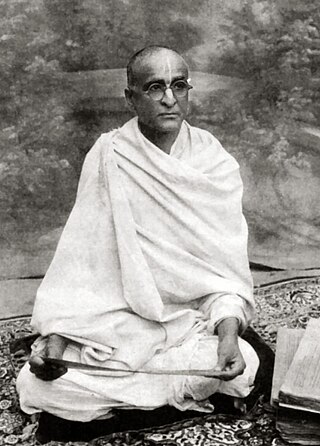
Bhaktisiddhanta Sarasvati, born Bimala Prasad Datt, was an Indian Gaudīya Vaisnava Hindu guru, ācārya, and revivalist in early twentieth-century India. To his followers, he was known as Srila Prabhupāda.

Gaudiya Vaishnavism, also known as Chaitanya Vaishnavism, is a Vaishnava Hindu religious movement inspired by Chaitanya Mahaprabhu (1486–1534) in India. "Gaudiya" refers to the Gaura or Gauḍa region of Bengal, with Vaishnavism meaning "the worship of Vishnu". Specifically, it is part of Krishnaism–Krishna-centric Vaishnavite traditions.

Dattatreya, Dattā or Dattaguru, is a paradigmatic Sannyasi (monk) and one of the lords of yoga, venerated as a Hindu god. He is considered to be an avatar and combined form of the three Hindu gods Brahma, Vishnu, and Shiva, who are also collectively known as the Trimurti, and as the manifestation of Parabrahma, the supreme being, in texts such as the Bhagavata Purana, the Markandeya Purana, and the Brahmanda Purana, though stories about his birth and origin vary from text to text. Several Upanishads are dedicated to him, as are texts of the Vedanta-Yoga tradition in Hinduism. One of the most important texts of Hinduism, namely Avadhuta Gita is attributed to Dattatreya. Over time, Dattatreya has inspired many monastic movements in Shaivism, Vaishnavism, and Shaktism, particularly in the Deccan region of India, Maharashtra, Gujarat, Madhya Pradesh, Rajasthan and Himalayan regions where Shaivism is prevalent. His pursuit of simple life, kindness to all, sharing of his knowledge and the meaning of life during his travels is reverentially mentioned in the poems by Tukaram, a saint-poet of the Bhakti movement.
Mahanubhava refers to Krishnaite Hindu denomination in India that was founded by Sarvadnya Shri Chakradhar Swami, an ascetic and philosopher who is considered as a reincarnation of Krishna by his devotees Some sources list the founders as Chakrapani and Govinda Prabhu with Shree Chakradhara Swami as the first "apostle" and propagator of Mahanubhava Pantha. Mahanubhava Sampradaya was formally formed in modern-day Varhad region of Maharashtra in 1267 CE. It has different names such as Jai Krishni Pantha in Punjab and Achyuta Pantha in Gujarat. Mahanubhava Pantha was also known as Paramarga by its followers in 13th century. Nagadevacharya, also known as Bhatobas, became the head of Sampradaya after Chakradhara.
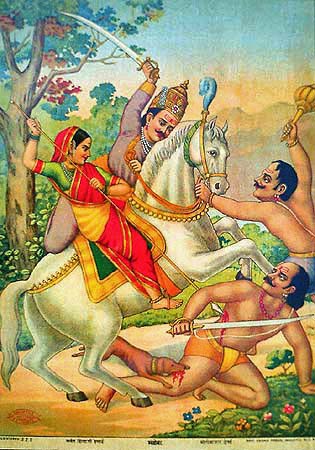
Khandoba, also known as Martanda Bhairava and Malhari, is a Hindu deity worshiped generally as a manifestation of Shiva mainly in the Deccan Plateau of India, especially in the state of Maharashtra and North Karnataka. He is the most popular Kuladevata in Maharashtra. He is also the patron deity of some Kshatriya Marathas (warriors), farming castes, shepherd community and Brahmin (priestly) castes as well as several of the hunter/gatherer tribes that are native to the hills and forests of this region.

The Ramanandi, also known as Ramavats, is one of the largest sects of Vaishnavas. Out of 52 sub-branches of Vaishnavism, divided into four Vaishnava sampradayas, 36 are held by the Ramanandi. The sect mainly emphasizes the worship of Rama, Sita, Hanuman, and the avatars of Vishnu. They consider Rama and Sita as the Supreme Absolute who are not different from each other. It is considered to have been founded by Ramananda, a 14th-century Vaishnava saint.

Upasani Maharaj, born Kashinath Govindrao Upasni, was an Indian spiritual teacher, considered by his disciples to be a satguru. He lived in Sakori, British India, and is said to have received God-realization from Sai Baba of Shirdi. Upasani himself was one of the principal masters of Meher Baba.

Mahima Dharma, also known as Mahima Panth, is a Hindu sect practiced primarily in Odisha and nearby states. The religious movement was based on the worship of God, known as ALEKH, as attributeless. as condemnation of all religious customs set by the rich and upper-class society generally.
The Shri Guru Charitra is a book based on the life of Shri Nrusimha Saraswati, written by the 15th-16th century poet Shri Saraswati Gangadhar.

Vaishnavism is one of the major Hindu denominations along with Shaivism, Shaktism, and Smartism. It is also called Vishnuism since it considers Vishnu as the sole supreme being leading all other Hindu deities, that is, Mahavishnu. Its followers are called Vaishnavites or Vaishnavas, and it includes sub-sects like Krishnaism and Ramaism, which consider Krishna and Rama as the supreme beings respectively. According to a 2020 estimate by The World Religion Database (WRD), hosted at Boston University’s Institute on Culture, Religion and World Affairs (CURA), Vaishnavism is the largest Hindu sect, constituting about 399 million Hindus.

Brahmachaitanya was an Indian Hindu saint and spiritual master. Brahmachaitanya was a devotee of the Hindu deity Rama and signed his name as "Brahmachaitanya Ramdasi". He was a disciple of Tukamai, and advocated for japa meditation with the Trayodaśakṣarī mantra of Rama to attain spiritual progress and liberation. The mantra is "Śrī Rāma Jaya Rāma Jaya Jaya Rāma " which is also known by other names such as Śrī Rāma Jaya mantra and Śrī Rāma Tāraka mantra.

Sat Vaishnavism, also referred to as Madhva Vaishnavism, the Madhva Sampradaya and the Brahma Sampradaya, is a denomination within the Vaishnavism—Bhagavata tradition of Hinduism. Sadh Vaishnavism was founded by thirteenth century philosopher-saint Madhvacharya, who developed the Tattvavada (dvaita) Vedanta sub-school of Hindu philosophy.
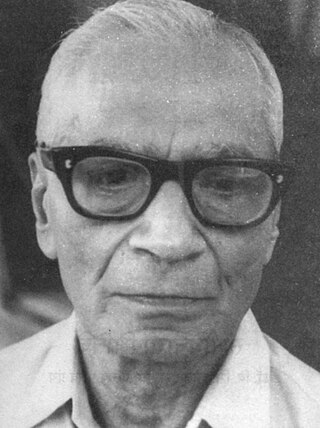
Vishnu Bhikaji Kolte (1908–1998), popularly called Bhausaheb Kolte was a Marathi writer and researcher of old Marathi literature. He hailed from Maharashtra, India. He served as Vice chancellor in Rashtrasant Tukadoji Maharaj Nagpur University.

Ram Charan (1720–1799)) is the Rajasthani Hindu guru, inspirator of a religious tradition called Ramsnehi Sampradaya or Ramdwara. He initiated and illustrated Nirguna (absolute) Bhakti, although he was not against Saguna Bhakti. He initiated and tried to eliminate "show", blind faith, hypocrisy and misled existing in the Hindu religion and preferred to worship the 'name of God', Rama, over God, to not get involved in false "show" activities.
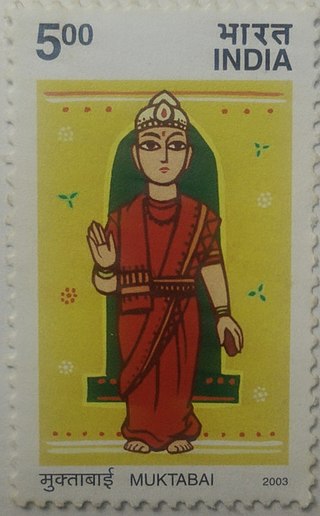
Muktabai or Mukta was a saint in the Varkari Movement. She was born in a Deshastha Brahmin family and was the younger sister of Dnyaneshwar, the first Varkari saint. She wrote forty-one abhangs throughout her life.
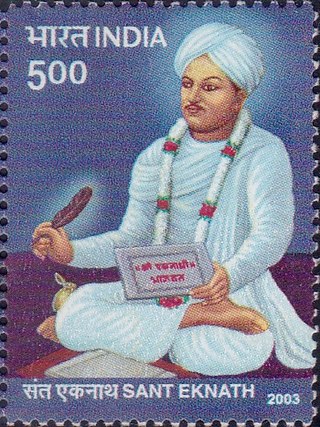
Eknath (1533–1599), was an Indian Hindu Vaishnava saint, philosopher and poet. He was a devotee of the Hindu deity Vitthal and is a major figure of the Warkari movement. Eknath is often viewed as a spiritual successor to the prominent Marathi saints Dnyaneshwar and Namdev.
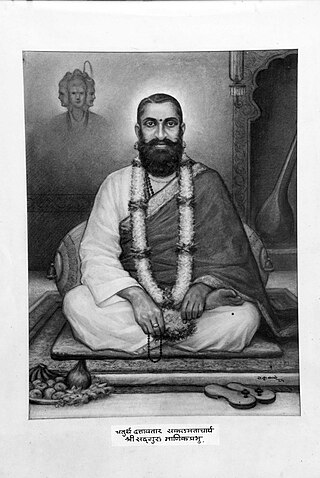
Manik Prabhu Maharaj was an Indian Hindu saint, freedom fighter, philosopher, poet and guru. He is also regarded as an incarnation of Dattatreya by the people of Datta Sampraday. Prabhu's philosophy, the Sakala mata Siddhanta rests on the principles of Advaita Vedanta as propagated by Adi Sankara. Shri Prabhu strongly advocated the essential oneness of all religions. Prabhu's Muslim devotees revered him as an incarnation of Mehboob Subhani whereas his Lingayat devotees saw him as a form of Basavanna. Shri Prabhu composed numerous bhajans and padas in various languages such as Marathi, Kannada, Hindi, Urdu and Sanskrit. Shri Prabhu was also associated with the First War of Indian Independence in 1857. Shri Sai Baba of Shirdi, Shri Swami Samarth of Akkalkot, Shri Bramhachaitanya of Gondavale and many other contemporary saints are believed to have visited Maniknagar to interact with Prabhu on matters of deep spiritual wisdom. Biographers refer to Shri Prabhu as a saint of great spirituality and mysticism. Shri Prabhu's teachings emphasize the path of Bhakti. He also moralized on the vedantic truths concerning the spiritual unity of beings. Manik Nagar, Humnabad, Bidar District is the place where he took sanjeevani samadhi. Shri Prabhu's samadhi at Maniknagar is the nucleus of Manik Nagar and acts as the spiritual center of the activities of Shri Manik Prabhu Samsthan.
Mhaimbhat was one of the earliest followers of Chakradhar Swami and the Mahanubhava sect, and author of Leela Charitra, the first biography written in the Marathi language.

Pant Maharaj, born Dattatreya Ramchandra Kulkarni, was a Hindu yogi and guru in the Belgavi region of India and is regarded by his devotees as a saint and an incarnation of Dattatreya.

















